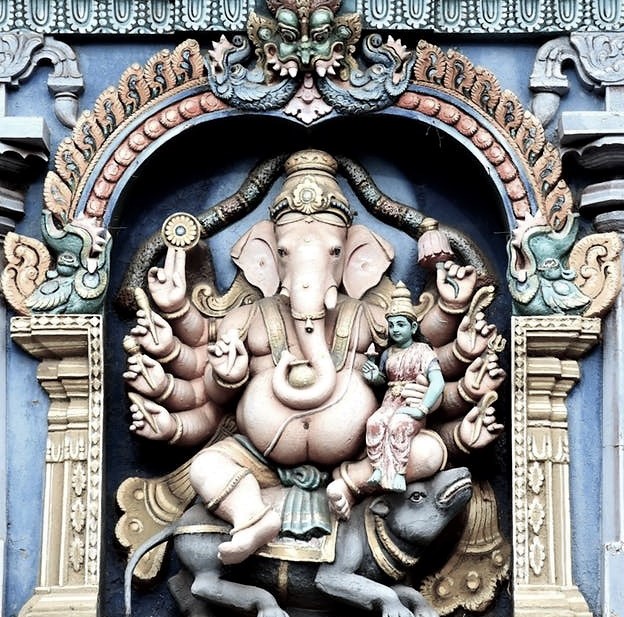- Special FeaturesFoundation YearSthala TreeTheerthamRathamArchitectureOther Speciality
- Sthala Puran
Sri Adi Shankaracharya, the pre-eminent philosopher saint of the 8th century CE and the principal exponent of Advaita Vedanta, established four pithams (dioceses) in India to preserve and propagate Sanatana Dharma and Advaita Vedanta. These were Sringeri Sri Sharada Peetham (Karnataka) in the South, Dvārakā Śāradā Pītham (Gujarat) in the West, Purī Govardhan Pīṭhaṃ (Odisha) in the East and Badri Jyotishpīṭhaṃ (Uttarakhand) in the North. He also instituted the tradition of appointing a succession of monastic pontifical heads, called the Jagadgurus, to each of the four monasteries, installing Sri Sureshvaracharya, Sri Hastamalakacharya, Sri Padmapadacharya and Sri Totakacharya as the first Jagadgurus of the Peethams at Sringeri, Dvaraka, Puri and Badri respectively
- Architecture
The Sringeri matha includes two major temples. One is dedicated to Shiva and is called the Vidya Shankara temple, the other to Saraswati and is called the Sharada Amba temple. The earliest version of the Shiva temple was built in the 14th-century, of goddess Saraswati in the 15th-century.
The Vidyashankara temple is a fusion of pre-Vijayanagara Hindu temple architecture traditions with Hoysalas and Vijayanagara styles, giving it an unusual appearance. The temple has an apsidal shape with its interior chambers and sanctum set on the square principle while the spire and outer walls use an almost circular plan. The temple is set on a high plinth like the Hoysala temples, with the basement adorned with sculpted animals and balustrades with yalis flanking the steps.The outer walls of the Shiva temple have large sculptured panels at right angles to each other and these show the major gods and goddess of Vedic tradition and post-Vedic Shaivism, Vaishnavism, Shaktism, Saurism (Surya) and Ganapatya (Ganesha) traditions of Hinduism.The base of the temple have relief friezes depicting a large variety of stories from Hindu epics and puranas. The sanctum has a linga, the southern side of the sanctum features Brahma-Sarawati, the western side Vishnu-Lakshmi, and the northern side Shiva-Parvati.
The temple can be entered from four directions. Inside the temple is a large mandapa with intricately carved pillars, several antechambers with artwork, a sanctum with linga and a circumambulation passageway around it. The passageway opens to smaller shrines dedicated to Hindu gods and goddesses from various Hindu traditions. According to George Michell, the current Vidyashankara temple reflects the 16th-century additions.
Saraswati, the goddess of knowledge and arts in the Hindu tradition, is the presiding deity of the monastery. The monastery tradition states that Adi Shankara installed a sandalwood image of Saraswati as Saradamba in a simple shrine, one that was replaced with its current copy in gold during the Vijayanagara era. The shrine was rebuilt in the 15th-century and expanded in early 20th-century. The temple has a maha-mandapa (main hall) with images of saptamatrikas (seven mothers) sculpted. The goddess sits in a golden chariot. Along with Saraswati in the sanctum, the temple has small shrines for Ganesha and for Bhuvaneshvari.The Saradambda temple and nearby structures additionally house a library, a Vedic school, a shrine for Adi Shankara, and other facilities of the monastery. It has been the historic epicenter of Sringeri's annual Navaratri festival celebrations, as well as the chariot festival held in February or March every year. The temple also gives the site its name, with "Sarada peetha" meaning "seat of learning". The temple was renovated to its current form in 1916.
- Alankar of Deity
- Prayers and BenefitsSpecial Vratas and PrayersOfferings to DeityStotras and Mantras
- Festivals
- Sodasha Upcharas
- Prasadhas
- Social ActivitiesAnnadhanMarriageEar BoringHead ShaveDanaasEducation FacilitiesSocial DrivesOther Activities
- Arjita Seva
- Tags

